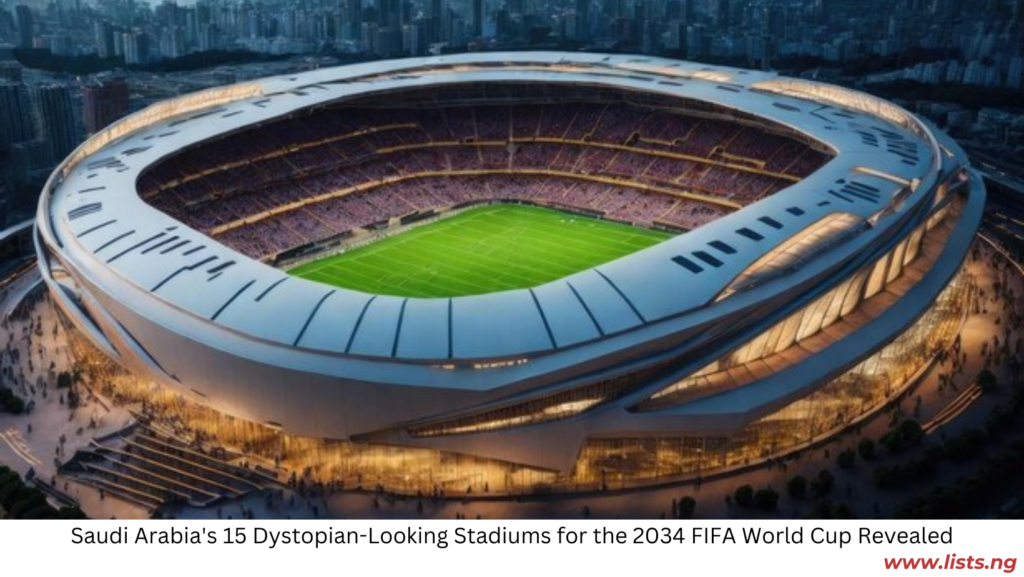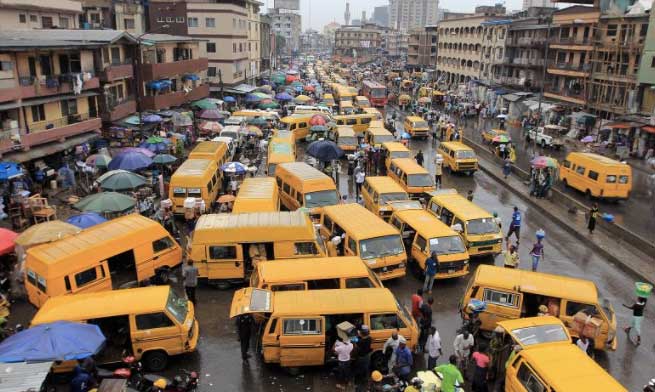As the only bidder for the World Cup, Saudi Arabia is anticipated to host the 2034 FIFA World Cup, with formal confirmation expected in December 2024. The kingdom has unveiled the stadiums that will host World Cup games in ten years, including one built on The Line at Neom and another inspired by the bark of a tree.
According to the plan, Saudi Arabia intends to build 11 new stadiums and renovate four existing ones. The 15 stadiums, announced as part of its official bid application to FIFA, would be located in and around four cities: Riyadh, Jeddah, Al Khobar, and Abha, as well as the under-construction The Line. This announcement has sent shockwaves of excitement through the football world, and we can’t wait to get into the details.
- The King Salman International Stadium in Riyadh
The stadium was designed by Populous and will be Saudi Arabia’s largest stadium, with a capacity of 92,000 seats. It will host both the opening and final matches of the World Cup. The structure of the stadium was inspired by mountains, and renderings show the building surrounded by landscaped panels.
According to the final proposal, “The stadium will blend into its surrounding topography, with terrain and natural habitat forming part of the stadium’s roof.” Aside from its aesthetic appeal, this design will provide effective shading and ventilation tailored to the desert climate, ensuring comfort for fans.
- King Fahd Sports City Stadium in Riyadh
The stadium is currently undergoing major renovations to improve amenities, aesthetics, and the overall fan experience. Originally constructed for 58,000 people, it now hosts Saudi Professional League (SPL) games with an average attendance of roughly 23,000 for key events. Recent developments aim to increase the stadium’s capacity to over 70,200 seats and develop it into a comprehensive football city that can also host concerts, festivals, and other events.
- Prince Mohammed bin Salman Stadium in Riyadh
The stadium, named after Saudi Crown Prince Mohammed bin Salman, is proposed for the Qiddiya entertainment zone, 30 km from Riyadh. The structure will also house an Olympic Museum. The stadium will have a seating capacity of 46,979 and a three-sided design with views of the picturesque Tuwaiq cliffs. Its futuristic appearance is accomplished with iridescent glass, LED screens, solar panels, and perforated metal.
The stadium, located about 35 km southwest of Riyadh, is part of the wider Qiddiya complex, which will contain numerous sports facilities, luxury apartments, and 58 other attractions. After the World Cup, it will operate as a multipurpose facility for sports, concerts, and esports, as well as an Olympic Museum commemorating the country’s Olympic and Paralympic successes.
- New Murabba Stadium in Northwest Riyadh
This proposed stadium is located in the northwest of Riyadh and is expected to open in 2032 with a capacity of over 46,010. The design, influenced by the bark of local acacia trees, features lit fissures that act as entrances and lead to spaces beneath a covered canopy. The roof offers shaded areas for gatherings and movement. After the World Cup, the stadium will be transformed for outdoor dining, gaming, and music. This looks to be an exciting addition to sporting activities in Saudi Arabia.
- ROSHN Stadium, Riyadh
Located in the southwest of Riyadh, the new ROSHN Stadium can accommodate more than 45,000 spectators. Its crystal-like structure that sparkles at night, along with its saddle-shaped seating bowl and adjustable stand heights, are intended to offer comfort, shade, and cross-ventilation. It also features parabolic geometry for sonic amplification.
The stadium is scheduled to open to the public in 2032, with construction set to start in 2028. In contrast to conventional sports arenas, the stadium is built to blend in with the cityscape, promoting community exploration with a central plaza encircled by a ‘crystalline’ structure that resembles a lattice and will light up the night sky.
- Prince Faisal Bin Fahad Sports City Stadium in Riyadh
Populous envisions the Prince Faisal bin Fahad Sports City Stadium in Riyadh as a new multi-purpose facility inspired by Salmani architecture’s ‘culturally contextualized modernism.’ Built using locally produced materials and energy-efficient features, including large solar panels on the roof, the new stadium is designed to accommodate 46,865 people.
The stadium is currently under development and is projected to be completed in 2027. It is located near metro lines and bus networks that connect it to the rest of Riyadh.
- South Riyadh Stadium
The new stadium, designed by Populous, will be located in southwest Riyadh and will have a capacity of over 45,000 seats. The exterior will combine modern aspects with traditional local architecture and materials. To conserve water, the landscaping will incorporate native, drought-resistant plants, as well as rainwater gathering equipment. Solar panels will be built into the design to generate renewable energy and demonstrate a commitment to environmental responsibility.
After the FIFA World Cup in 2034, the facility will host a professional football club, as well as various sporting and entertainment events. The South Riyadh Stadium is part of the larger Green Riyadh project, which will include open spaces, marketplaces, and green areas. The new venue is slated to open to the public in 2032, with construction beginning in 2029.
- King Saud University Stadium in Riyadh
King Saud University Stadium, located on the university’s campus west of Riyadh, is currently home to the Al Nassr football club. The 25,000-seat stadium, designed by Michael KC Cheah and Steph, is one of two existing stadiums that will be temporarily expanded to 46,000 seats for the World Cup.
Following the event, it will revert to a capacity of 33,000 spectators, serving university teams and community events. The restoration, to be carried out by Hashem Contracting Company, will begin in 2030 and be completed in 2032.
- King Abdullah Sports City Stadium in Jeddah
The King Abdullah Sports City Stadium, established in 2014 by Arup Consulting, is Saudi Arabia’s second-largest stadium, seating over 57,000 people. It is home to the Al Ittihad and Al Ahli football clubs, with major events attracting an average of 46,000 people.
Known as ‘The Shining Jewel’ due to its striking geometric architecture, it serves as a significant football event location. The stadium, which will host the AFC Asian Cup in 2027, also played a key role in the FIFA Club World Cup Saudi Arabia 2023, with an average attendance of 50,000.
- Qiddiya Coast Stadium, Jeddah
The stadium, also designed by Populous, will be located on the northern banks of the Red Sea in Jeddah and will have a spectator capacity of over 45,000. It is designed to represent the dynamic relationship between people, water, energy, and matter, with undulating patterns and a brilliant color palette reminiscent of the ripple effect of a ‘Mexican wave.’
The design features different spaces that flow fluidly together, providing abundant meeting opportunities for spectators and communities beyond the stadium. Construction is set to commence in 2029 and be completed in 2032.
- Jeddah Central Development Stadium, Jeddah
The stadium, built in the seaside Al Andalus district of southwest Jeddah, has over 45,000 seats and combines traditional Al Balad architectural elements with modern technology. The design consists of three layers: a semi-translucent roof, a retractable inner roof, and a 360° LED screen.
It will be bordered by four interconnected villages that provide a variety of amenities. GMP Architect will lead the Jeddah Central Development (JCD) Stadium. Following the 2034 World Cup, the stadium will host professional football games and various events, including conferences and concerts.
- King Abdullah Economic City Stadium in Jeddah
The King Abdullah Economic City Stadium, situated north of Jeddah on the Red Sea Coast, will have approximately 45,000 seats. Its design, inspired by local coral reefs, prioritizes adaptability and organic aesthetics. The stadium is part of a wider project aiming at promoting economic development, environmental sustainability, and community cohesion. The area will include three hotels, mixed-use buildings, and a sports clinic.
- ARAMCO Stadium in Al Khobar
The new stadium’s current design was created by the US-based architecture firm Populous after it was initially envisioned by Foster + Partners. It is currently being built in northern Al Khobar, near the Corniche, and will have a capacity of over 45,000 seats when completed in 2026.
The stadium will serve as a main venue for the 2027 AFC Asian Cup and the 2034 FIFA World Cup. Following the World Cup, it will become the home of a professional football club, complete with superior training facilities, as well as commercial and retail spaces.
- The King Khalid University Stadium in Abha
The stadium has been hosting events with an average attendance of 22,000 in the last two years. In preparation for the FIFA World Cup 2034, the stadium will be temporarily expanded to accommodate over 45,000 people. Populous’ renovation plans will upgrade infrastructure while preserving the stadium’s historical significance, including a new permanent west stand and updated technology. Following the World Cup, the stadium will continue to function as a professional football club’s home ground, as well as a venue for various community events.
- Neom Stadium at The Line
Neom Stadium, located within The Line, is set to become an iconic landmark, with its pitch elevated over 350 meters above ground, providing spectacular views and a roof integrated into the city’s structure. With a capacity of more than 45,000, the stadium will use cutting-edge technologies like e-ticket gates and 4K Ultra HD transmission to enhance the experience for FIFA players, spectators, and broadcasters.
Neom Stadium will be located in the center of a new sports-focused community, close to the Health and Well-Being District and the University, and will be easily accessible from multiple levels of The Line. The stadium will run entirely on renewable energy from wind and solar, including electric transit systems. Construction is expected to start in 2027, with completion anticipated in 2032.
Wrapping Up,
The promised investment in these modern facilities highlights Saudi Arabia’s commitment to creating a robust sports environment that aligns with its Vision 2030 aspirations. As the world prepares for the 2034 FIFA World Cup, all eyes will be on Saudi Arabia, and these magnificent venues will undoubtedly make a lasting impression on the global sports community.



